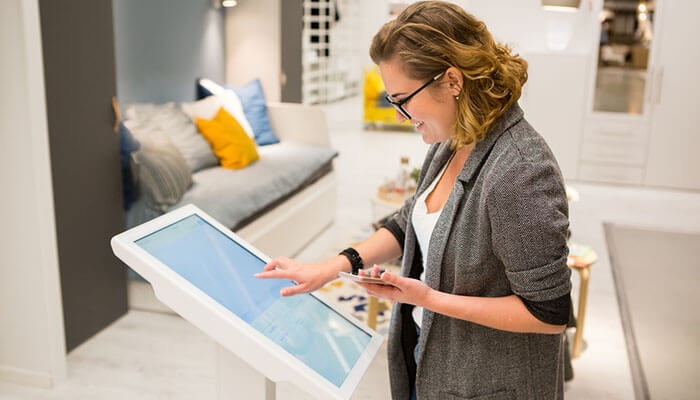The retail industry is changing rapidly, and the way customers shop has also changed. The advent of e-commerce made it easier for consumers to buy products online. But that doesn’t mean they don’t want to visit brick-and-mortar stores anymore.
Shopify mentioned that 81% of Generation Z consumers prefer in-store shopping. As more consumers use their smartphones or tablets, they find in-store shopping a perfect solution to do away with their gadgets and the online realm.
To keep up with this trend, implementing kiosks can be an effective strategy to elevate your in-store experience. However, setting it up requires some planning and preparation. In this article, you’ll learn how to set up a kiosk to enhance your in-store experience. So, read on for the insight.
What Is A Kiosk?
A kiosk is a self-service terminal used to provide services to customers. It’s a computerized device that allows users to interact with it without assistance from store employees.
Kiosks have been around since the 1970s when IBM first introduced them. Since then, they’ve become popular among retailers because they’re cost-effective and convenient.
Many self service Kiosks solutions providers like Meridiankiosks offer turnkey systems that include everything needed to get started. These systems allow businesses to quickly deploy them into their stores. They also come with preinstalled software that makes it easy for users to operate the system.
Today, kiosks help businesses save time and money. They allow shoppers to browse product information, compare prices, make purchases, and even return items without waiting in line.
Setting Up A Kiosk
Before you start setting up a kiosk, there are several things you need to consider. As a business owner, you have to factor in several considerations to ensure that it will serve its purpose of improving customer experience and helping promote business growth. So, before setting up one, you need to:
1. Determine The Type Of Kiosk You Need
There are different types of kiosks available today for various purposes. Identifying your needs will help you determine which kind of kiosk best suits your business. You may consider these options depending on what industry you’re in and what products or services you offer:
1. Employment Kiosks: These kiosks are designed for hiring new employees. They offer applicants a quick and easy way to apply for jobs.
2. Food & Beverage Kiosks: If you run a restaurant or bar, you can use a food and beverage kiosk to serve drinks and snacks to customers.
3. Healthcare Kiosks: The healthcare industry is also adopting kiosks to improve customer service, process transactions, and set up appointments.
4. Sales Kiosks: Sales kiosks are ideal for selling merchandise like clothing, accessories, electronics, etc.
Knowing what kiosk you need for your business will help guarantee favorable benefits for your business. In a nutshell, your business type will significantly influence the one you need.
2. Consider The Space It Requires
Depending on your store’s size, you may need to choose between a stationary or portable kiosk.
If you plan to install a stationary kiosk, you should ensure enough space to accommodate all the equipment needed to operate it. Stationary kiosks require electricity and a power source. Also, if you plan to place them inside a store, you’ll need to check whether the location is suitable for installing such devices.
Portable kiosks are easier to move around than stationary ones. They don’t require any electrical outlets or power sources. Instead, they rely on batteries. These are perfect for small businesses with limited space.
3. Take Note Of The Features
Before shopping for one, you’ll need to decide what features you want your kiosk to include. Some essential kiosk features to look out for include the following:
1. Touchscreen Display: A touchscreen display is essential for operating a kiosk and providing a user interface that allows customers to access various functions using their fingertips.
2. Printer: A built-in printer is necessary for printing transaction receipts.
3. Speakers: If you want to provide customers with audio instructions about using your kiosk, you’ll need to equip it with speakers.
These valuable features will help customers have a seamless interaction with the kiosk. So, it’s best if you buy one with these.
4. Don’t Forget About The Cost
The cost of kiosks depends on their features and specifications. Generally speaking, the more features it offers, the higher the price tag.
Here’s a list of factors that influence the cost of a kiosk:
1. Size: Smaller kiosks tend to be cheaper than larger ones because smaller kiosks usually have fewer components and less functionality.
2. Functionality: More functional kiosks tend to be pricier than those that lack certain features.
3. Brand: High-end brands typically command higher prices than low-cost brands.
If you have the money, get a kiosk with jampacked features. Your customers will be delighted once they use them. But if you’re on a budget, buy one with only the essential but fundamental ones you need.
5. Decide On Where You Want It Installed
Once you’ve decided which type of kiosk you’d like to purchase, you’ll need to determine where you want to put it.
If you’re planning to install a kiosk inside your store, you’ll need a clear area to place it. Make sure there isn’t anything else blocking the view of the device. Ideally, indoor kiosks should be placed near the entrance of the store.
Meanwhile, if you want to set up a kiosk outside your store, be sure it doesn’t block customer traffic. Also, consider placing it in a prominent spot where people can see it from afar.
6. Choose Your Payment Options
Most kiosks offer different payment methods, including credit cards, debit cards, cash, and gift cards. Depending on the model, you may also be able to accept payments via mobile phone apps.
Final Thoughts
Kiosks are great tools for improving the in-store experience. With just a few simple steps, you can easily set them up. Once they’re ready, you can start leveraging your kiosk to improve the customer experience and boost profits.



